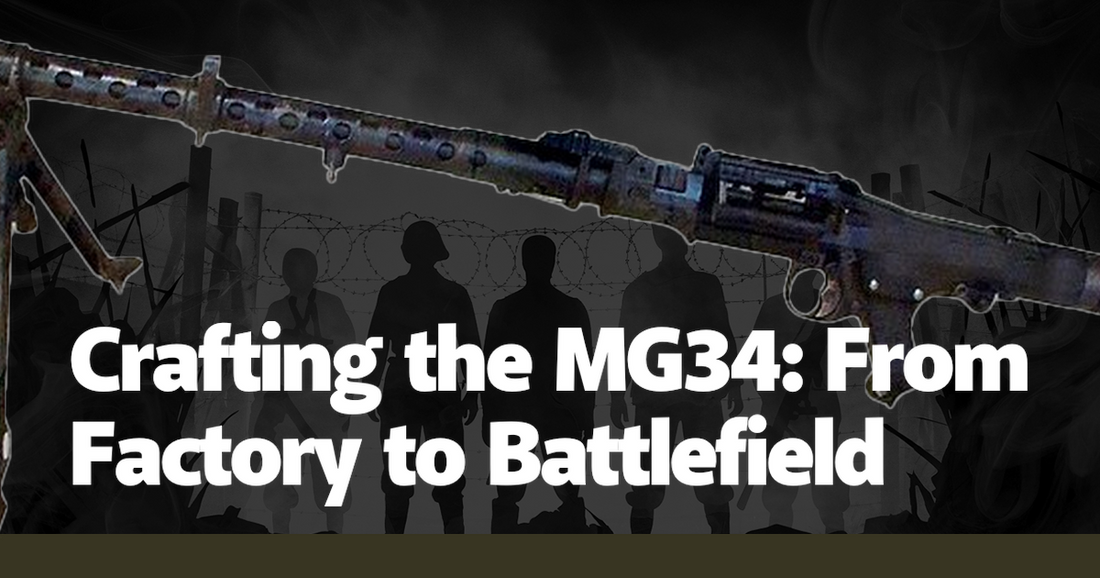The MG34, a marvel of German engineering, stands as one of the most iconic machine guns of World War II. Its inception began in the early 1930s, when the German military sought a versatile, reliable, and efficient weapon that could serve multiple roles on the battlefield. The weapon was designed by Heinrich Vollmer of Mauser Industries, and its production was a testament to the precision and ingenuity of German industry. The MG34's design incorporated a recoil-operated, air-cooled system, which allowed for rapid firing without the need for cumbersome water-cooling systems. This innovation was crucial for the fast-paced, mobile warfare that would come to define the era.
The manufacturing process of the MG34 was intricate and required a high degree of craftsmanship. Each component was meticulously crafted, with tolerances so tight that even the slightest deviation could render the weapon inoperable. The barrel, for instance, was forged from high-grade steel and rifled with exacting precision to ensure consistent accuracy and durability. The receiver, the heart of the machine gun, was milled from a single block of steel, a process that was both time-consuming and expensive but necessary for the weapon's reliability. The assembly line at Mauser's Oberndorf factory was a hive of activity, with skilled machinists and laborers working in concert to produce the finely-tuned components that would be assembled into the final product.
Once assembled, each MG34 underwent rigorous testing to ensure it met the stringent standards set by the German military. The weapon was subjected to various stress tests, including firing thousands of rounds to test its durability and reliability under combat conditions. Anecdotes from factory workers reveal a sense of pride in their work, knowing that their craftsmanship would be put to the ultimate test on the battlefield. One worker recalled how he felt a mix of anxiety and pride when he saw a photograph of an MG34 he had assembled being used by soldiers on the front lines.
The MG34's versatility was one of its most significant advantages. It could be mounted on a bipod for use as a light machine gun, on a tripod for sustained fire as a medium machine gun, or even on vehicles and aircraft. This adaptability made it an invaluable asset to the German military, capable of providing suppressive fire in a wide range of combat scenarios. The weapon's rate of fire, adjustable between 800 to 1,200 rounds per minute, allowed it to lay down a withering hail of bullets, making it a formidable opponent for any infantry unit.
In the hands of a well-trained gunner, the MG34 was a fearsome weapon. German soldiers were rigorously trained in its operation, maintenance, and tactical deployment. They learned to quickly change barrels to prevent overheating and to clear jams under fire, ensuring that the weapon could continue to deliver its deadly payload even in the most intense combat situations. Stories from veterans highlight the weapon's impact on the battlefield. One soldier recounted how the MG34's firepower turned the tide during a desperate defensive action, allowing his unit to hold their position against overwhelming odds.
Despite its many advantages, the MG34 was not without its flaws. Its complex design and the precision required for its manufacture made it expensive and time-consuming to produce. As the war dragged on and resources became scarcer, the German military sought a more cost-effective solution, leading to the development of the MG42. However, the MG34 remained in service throughout the war, a testament to its effectiveness and the high regard in which it was held by those who used it.
The legacy of the MG34 extends beyond its service in World War II. It influenced the design of future machine guns and remains a subject of study for military historians and firearms enthusiasts. Its blend of innovation, craftsmanship, and battlefield effectiveness makes it a fascinating example of military technology. The stories of those who built and used the MG34 offer a window into the human side of war, revealing the pride, determination, and ingenuity that went into crafting a weapon that would leave a lasting mark on history.
In conclusion, the MG34 is more than just a machine gun; it is a symbol of the technological and industrial prowess of its time. From the factory floors of Mauser Industries to the battlefields of Europe, it played a crucial role in the German military's strategy and tactics. Its design and manufacture required a level of skill and precision that speaks to the dedication of those who built it. The experiences of the soldiers who wielded it in combat underscore its impact and effectiveness. The MG34's story is a compelling chapter in the history of military technology, one that continues to capture the imagination of those who study it.

